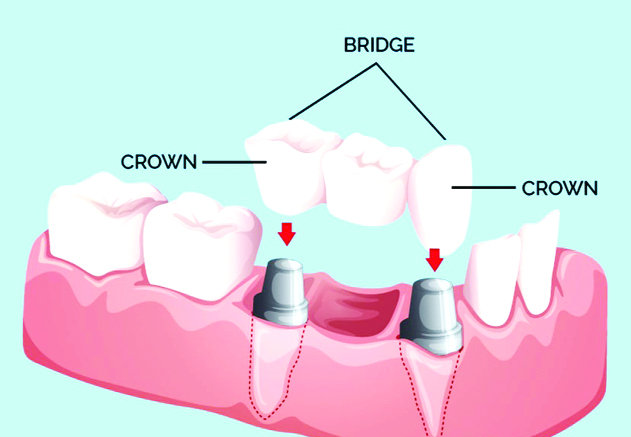Dr Reecha Gupta, Dr Mohit Gupta
Oral health is an integral part of a person’s overall general health and well-being. The loss of one or more teeth can lead to functional as well as psychological or aesthetic limitations, thus affecting the overall quality of life. Prosthodontics is a branch of dentistry that specializes in replacing missing teeth with removable or fixed teeth, i.e. crown and bridge.
Here are some frequently asked questions about Crown and Bridge that may help the general public.
What is a Dental Bridge?
* Referred to as fixed partial denture (FPD)
* It is a prosthesis that replaces one or more missing teeth. This cannot be removed by the patient, but the doctor can remove it if required.
Is it better than a partial denture removal?
* Definitely yes. If all other factors are favorable, a bridge / FPD is a better choice. FPD is very similar to the natural teeth in the mouth which are fixed and cannot be removed unlike a removable partial denture.
* With FPD, one can speak better, chew better and also improve aesthetics as minor tooth irregularities can also be corrected.
How is it supported?
* A dental bridge or FPD supports the teeth adjacent to the area of missing teeth on both sides, just as a bridge is supported by two abutments on either side.
How is it attached to the mouth?
* The bridge or FPD is fixed in the mouth with the help of special cements called groove cement.
* There are many types of cement mortars used depending on the type of bridge being designed.
What are the different parts of a bridge?
* The FPD generally consists of three parts:
1-The part above the support tooth or teeth called retention.
2-The part of the bridge that replaces the missing tooth or teeth is called the pontic. 3-Pontic and retainer and different units are joined by Connector to each other.
Do crown and bridge require root canal treatment?
* No, not every crown and bridge case requires root canal treatment.
Is FPD or bridge possible in all cases?
* No, it is not possible in every case. It has its own indications and contraindications.
When do you need a crown and bridge?
* Replacement of missing teeth
* Repairing a cracked, chipped or fractured tooth.
* After root canal treatment..
* Discolored teeth.
* Small distance between the teeth.
* To correct minor irregularities.
* Splint for the correction of grade 1 tooth mobility.
What is the treatment process for crown and bridge?
* The tooth or teeth to be crowned or covered are first prepared by a dentist according to the specifications of the desired crown. An impression is made and sent to the dental laboratory. Shades are matched. The dental laboratory then manufactures the crown according to the specifications given by the dentist. The crown is then tried on in the patient’s mouth, adjusted and then fixed in the patient’s mouth with special cement for this purpose.
Will I be able to eat comfortably with my crown teeth?
* Yes, just like normal teeth with proper precautions.
How long do they last?
* With proper care and hygienic maintenance, the crown and bridge last a long time.
* However, a periodic cleaning and check-up enhances the life of any oral prosthesis.
What are the different materials that make up a crown and bridge?
* FPD can be –
* All metal
* Metal ceramic
* Metallic acrylic
* No metals or all-ceramics
What are the different types of bridges?
* Traditional or conventional
* Implant supported
* Projectile bridge
* Maryland or resin bridge.
Bridge failure?
* Mechanical damage, in case of breakage of any part of the bridge.
* Poor oral hygiene.
* Inappropriate eating habits or dysfunctional habits.
* Aesthetic failure
Is the crown and bridge safe?
* Yes very much. All materials are biocompatible and bioinert.
What problems might you face at first after crown and bridge treatment?
* There may be a slight sensation of a foreign body in the mouth at first. A little sensitivity that will gradually disappear with time.
How do I care for my crown and bridge?
* As the dental crown is designed to last a long time, maintain good oral hygiene, tooth brushing, proper mouth rinsing.
* Avoid habits like biting objects or nails, very hard or sticky foods, avoid clenching and go for regular dental checkups.
What foods should be avoided to prevent any damage to the crown and bridge?
* Patients are usually advised to avoid extensive chewing of items such as chewing gum, sticky foods, candies, or very hard foods.
(Dr Reecha Gupta – Head of Department in Postgraduate Department of Prosthodontics And Crown & Bridge, IGGDCJ. Dr Mohit Gupta – Consultant Orthodontist.)

